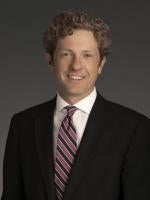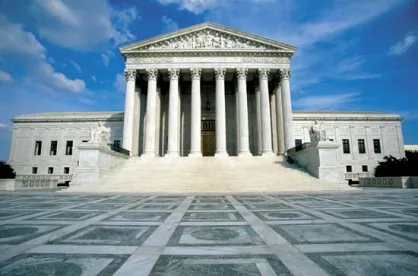Greetings, Court Fans!
As we reported earlier in the week, The Nine handed down one of the most hotly anticipated decisions of the term on Monday, and boy did it deliver! Wait. Sorry, strike that. It turns out the 7-2 decision in Masterpiece Cakeshop v. Colorado Civil Right Commission (No. 16-111), mostly delivered a lesson in how to avoid difficult questions when you regret granting cert and a lecture on not openly demeaning a party's religious beliefs when deciding his case.
The facts of the case are uncomplicated and no doubt familiar to most Court watchers. Jack Phillips, a baker with a shop in Colorado, refused to bake a wedding cake in 2012 for a gay couple, Charlie Craig and David Mullins. The couple filed a complaint with the Colorado Civil Rights Commission under the Colorado Anti-Discrimination Act (CADA), alleging unlawful discrimination on the basis of sexual orientation. Phillips argued that the First Amendment protected his decision, as a matter of both free speech and free exercise of religion, not to create a cake that celebrated same-sex marriage. The Commission rejected his arguments, concluding that requiring Phillips to prepare a wedding cake for a same-sex wedding did not compel him to express any message with which he disagreed, and that the State was merely enforcing a neutral antidiscrimination law of general applicability that did not implicate Phillips's religious exercise rights. The Colorado Court of Appeals affirmed, and the Colorado Supreme Court declined review.
By a 7-2 vote, the Court reversed. Writing for a majority of all but Justices Ginsburg and Sotomayor, Justice Kennedy began by teeing up some of the nettlesome issues he would proceed to not decide: "The case presents difficult questions as to the proper reconciliation of at least two principles. The first is the authority of a State and its governmental entities to protect the rights and dignity of gay persons who are, or wish to be, married but who face discrimination when they seek goods or services. The second is the right of all persons to exercise fundamental freedoms under the First Amendment, as applied to the States through the Fourteenth Amendment." The most Kennedy said about these competing constitutional concerns is that, whether the First Amendment requires an exception to antidiscrimination laws will depend on the specific facts of the case. But in this case, the facts the Court ended up relying on were not about the nature of Phillips's work, or his beliefs, or his interaction with Craig and Mullins. Instead, the decision turned on the fact that one or more of the Commissioners who handled the couple's complaint displayed apparent animus toward Phillips's religious beliefs. As Justice Kennedy observed, the First Amendment does not prevent states from enacting neutral and generally applicable laws that have the effect of burdening someone's religious exercise, but a law ceases to be neutral when it is enacted or applied with the intent to discriminate on the basis of religion. He concluded (consistent with some pointed questions he raised at oral argument) that Phillips was not treated with neutrality based on disparaging remarks certain Commissioners made about his beliefs, including calling "freedom of religion" a "despicable piece of rhetoric" used throughout history to "hurt others." (It didn't help that the Commissioner appeared to draw a comparison between Jake Phillips, cake artist, and Adolf Hitler, genocidal monster. Although only two of the seven Commissioners made hostile remarks, the remarks were never "disavowed at the Commission or by the State at any point in the proceedings."
Justice Kennedy also pointed to three other cases in which the Commission had permitted bakers to refuse to create cakes with images conveying disapproval of same-sex marriage. Kennedy rejected the state's claim that the Commission could legitimately treat those cases (and cakes) differently on the basis of "offensiveness," because "it is not . . . the role of the State or its officials to prescribe what shall be offensive."
In sum, the majority concluded that "[t]he Commission's hostility was inconsistent with the First Amendment's guarantee that our laws be applied in a manner that is neutral toward religion" and therefore reversed the judgment of the Colorado Court of Appeals.
But what happens next? What happens when Phillips or someone like him goes before a less openly "hostile" Commission? The fundamental questions at the heart of the case, Justice Kennedy announced, "must await further elaboration in the courts." But be forewarned "courts": you'll have to decide those questions "in the context of recognizing that these disputes must be resolved with tolerance, without undue disrespect to sincere religious beliefs, and without subjecting gay persons to indignities when they seek goods and services in an open market." Not to mention, without guidance from The Supremes!
With so many questions left unanswered by the majority opinion (which, in fairness, demonstrated sensitivity to the very difficult and potentially divisive issues in the case), Justices Kagan and Gorsuch stepped in to offer a bit more (conflicting) guidance. Joined by Justice Breyer, Kagan wrote separately to emphasize that although the state provided an unsatisfactory explanation for treating Phillips differently than the three other bakers, a satisfactory explanation was available. In refusing to produce a cake that conveyed disapproval of same-sex marriage, the other three bakers did not single out customers for different treatment—they would not have made such a cake for anyone. Phillips, in contrast, refused to sell the gay couple a cake that, even if custom designed, he would have sold to a straight couple. Vendors cannot evade antidiscrimination laws, the concurrence notes, by claiming that the sale of a product to a particular class of persons is inconsistent with their religious views. In other words, but for the ill-considered remarks from the Commissioners, it seems Kagan and Breyer would have ruled against Phillips.
Justice Gorsuch, joined by Justice Alito, filed a concurrence largely in rebuttal to Justice Kagan's. To Gorsuch, Phillips and the other three bakers were treated differently despite all facing essentially the same situation: They objected to the nature of the cake being requested, not the characteristics (sexual orientation or religious convictions) of the person requesting it. The gay couple had not requested merely a generic wedding cake, as Justice Kagan believed, because any cake for a same-sex wedding would be, at least in Phillips's eyes, an expression of approval of same-sex marriage. And because Phillips would not sell a cake celebrating same-sex marriage to anyone, including a straight couple, he should have been treated the same as the other three principled bakers.
Gorsuch also joined a third concurrence, authored by Justice Thomas, which concurred in part and in the judgment. Thomas zeroed in on the free speech question that the majority left unanswered and concluded that Phillips's cake making was a form of expressive conduct. Therefore, in Thomas's view, the State violated the First Amendment by attempting to compel Phillips to express a particular message that he disagreed with.
Justice Ginsburg was joined in dissent by Justice Sotomayor. They disagreed with the majority's conclusion that the Colorado Court of Appeals had distinguished the bakers from one another based on its own view of offensiveness. Rather, it had distinguished Phillips as someone who took offense at the idea of baking a generic cake for a protected class of persons—which he was not entitled to do under state law—from the other bakers who took offense at the very visible message they were being asked to help convey—which they were entitled to do. Echoing Justice Kagan, Justice Ginsburg pointed out that changing the protected characteristic in the Phillips case (the sexual orientation or sex of the customer) would have changed Phillips's willingness to sell the product, whereas the other three bakers would have refused to make the requested cake regardless of the religious views the customer might hold. Ginsburg also emphasized that the comments disparaging religion came from two members of a commission involved in but one of several layers of review, including later de novo review by the Colorado Court of Appeals.
The Justices ducked another tough (if less divisive) issue in Hughes v. United States (No. 17-155), a case that ended up being just about whether a prisoner sentenced pursuant to a "Type-C" plea agreement can benefit from later amendments to the Guidelines range, and not about how to interpret the precedential effect of a Supreme Court opinion with no clear majority. It was the latter, undecided, issue that most folks were looking for guidance on, but the Court's decision on the sentencing issue will at least be impactful for a large number of prisoners.
Back in 2011, in Freeman v. United States, the Court took up the issue of when a prisoner sentenced pursuant to a Type-C plea agreement—that is, one in which the prosecutor and defendant agree to a specific sentence or sentencing range—may be eligible for a sentencing reduction under 18 U.S.C. 3582(c)(2), which permits a reduction if a prisoner was sentenced "based on a sentencing range" that was later lowered by the U.S. Sentencing Commission. But the Court in Freeman was unable to provide an answer commanding a majority. In a plurality opinion authored by Justice Kennedy, four Justices concluded Type-C plea agreements are generally "based on" the applicable Guidelines range and, therefore, when the range is retroactively amended, a prisoner sentenced pursuant to a Type-C plea should be eligible for a reduction. But Justice Sotomayor penned a solo concurrence on narrower grounds, opining that, in most cases, it's the plea and not the Guidelines that a sentence is based on. She joined the judgment permitting Freeman's reduction because his plea agreement expressly referred to the Guidelines range, but for most prisoners sentenced under Type-C pleas, there was no clear majority rule coming out of the decision. (Meanwhile, the four more conservative justices dissented, concluding that sentences in Type-C cases are always based on the plea agreement, and not the Guidelines.)
In the subsequent years, lower courts split on whether to apply the plurality opinion or Justice Sotomayor's concurrence. Some circuits applied Justice Sotomayor's opinion, invoking the interpretive rule of Marks v. United States (1977), which held that "[w]hen a fragmented Court decides a case, . . . the holding of the Court may be viewed as that position taken by the Members who concurred in the judgment on the narrowest grounds." But others argued that Marks only applies where one opinion is a "logical subset" of the other. Because Justice Sotomayor's concurrence was not a narrower logical subset of Justice Kennedy's plurality opinion, these circuits followed the opinion they found more persuasive: the plurality's.
The Supreme Court granted cert primarily to resolve the question of how to apply the Marks rule when neither the plurality nor concurring opinion in a 4-1-4 decision is a logical subset of the other. But apparently deciding that question was harder than just deciding the original question that vexed them in Freeman. (Imagine a 4-1-4 decision on how to apply the Marks rule!)
This time, with Justice Sotomayor switching sides (and Justice Gorsuch throwing in his hat for good measure), the majority solidly concluded that a sentence imposed pursuant to a Type-C agreement is "based on" the defendant's Guidelines range for so long as that range was a "relevant part of the framework the judge used" in imposing the sentence. That meant Erik Hughes was eligible for a reduction, because the District Court accepted his Type-C agreement after concluding that a 180-month sentence was consistent with the Guidelines, and then calculated Hughes' sentencing range and imposed a sentence it deemed "compatible" with the Guidelines. The range was thus clearly part of the framework the sentencing judge used in imposing the sentence. Therefore, Hughes is eligible for a reduction now that the Guidelines range had been retroactively lowered by the Sentencing Commission.
Justice Sotomayor joined the majority opinion in full, this time writing separately only to explain her flip-flop. Though she continues to believe that her Freeman concurrence was correct, she recognized that the concurrence had caused difficulties in the lower courts, to the expense of uniformity in sentencing. "The integrity and legitimacy of our criminal justice system depend upon consistency, predictability, and evenhandedness. Regrettably, the divided decision in Freeman, and my concurrence in particular, have done little to foster those foundational principles." She therefore joined the majority in full "to ensure clarity and stability in the law."
The Freeman dissenters, meanwhile, remained unconvinced. Writing for the three survivors (Scalia having been the fourth), the Chief reiterated his view that a sentence imposed pursuant to a Type-C plea agreement, setting out a specific term of imprisonment, is always based on the plea agreement, not the Guidelines. It therefore makes no difference if the Guidelines are subsequently amended, because the prisoner's sentence was based on his agreement with the prosecution on an appropriate range, independent of the Guidelines.
The Court put its new test to work immediately in Koon v. United States (No. 17-5716). The five petitioners had pleaded guilty to drug conspiracy charges subjecting them to mandatory minimum sentences that were greater than the top end of their otherwise applicable Guidelines ranges. Because the mandatory minimums exceeded the top end of the Guidelines ranges, the sentencing judge discarded the ranges, but then departed downward under 18 USC 3553(e) to reflect the substantial assistance the petitioners provided to the Government. In setting the final sentences, the court did not consider the original Guidelines ranges it had earlier discarded. Under these circumstances, the Court unanimously agreed, the petitioners did not qualify for sentence reductions because their sentences were not "based on" the subsequently lowered Guidelines ranges. Instead, they were based on the mandatory minimums and the petitioners' substantial assistance to the Government. And that's pretty much all we've got to say about that!
While the Court ducked the hard questions in Masterpiece and Hughes, it did a little better in Lamar Archer & Cofrin v. Appling (No. 16-1215), deciding the important question whether "respecting" means something different than "related to" in the Bankruptcy Code.
Appling hired a law firm, Lamar, Archer & Cofrin, LLP to represent him in a business dispute. Appling fell behind on the bills, and the firm threatened to withdraw. Then, in an in-person meeting, Appling told the firm (orally) that he was expecting a $100K tax refund. Relying on this, the firm continued to represent him. Appling got his refund, but it was only $60K, and he promptly spent it on himself. (Clients!) When the firm asked where the refund was, he lied (again orally) saying he'd be getting it any day now. Unsurprisingly, he left the bill unpaid, and the firm sought to collect its debt, obtaining a judgment for more than $100,000. Shortly thereafter, Appling filed for Chapter 7 bankruptcy.
The firm initiated an adversary bankruptcy proceeding, arguing that Appling's debt was non-dischargeable because he had obtained legal services by means of false statements. Specifically, 11 U.S.C. § 523(a)(2)(A) provides that a debtor cannot discharge debts for services (among other things) arising from "false pretenses, a false representation, or actual fraud, other than a statement respecting the debtor's . . . financial condition." But not so fast, Appling argued, his false statement about a big tax return was a statement "respecting his financial condition." And 11 U.S.C. § 523(a)(2)(B) provides that debts arising from a materially false statement "respecting the debtor's . . . financial condition" can only be discharged if the statement was "in writing." The bankruptcy court and district court rejected Appling's argument that a one-off statement about a specific asset (the tax refund) was a statement "respecting his financial condition," so they found the debt non-dischargeable. But the Eleventh Circuit reversed. The Supreme Court then granted certiorari, to resolve a circuit split over whether a statement about one particular asset could be a statement respecting a debtor's financial condition.
Justice Sotomayor, writing for a unanimous Court, affirmed. Everyone agreed what a "statement" was. And everyone agreed what "financial condition" means. The law firm contended that "respecting" has a narrow meaning, narrower than words like "related to." (Lawyers!) This limits Section 523(a)(2)(B) to statements providing a detailed accounting of one's total assets and liabilities (like a financial statement or the statement that "My balance sheet looks great!") and doesn't include statements about a single asset. But the Court found no support for the law firm's attempt to categorize near synonymous like "respecting," "regarding," "about," or "concerning." And, more fundamentally, the law firm's reading would essentially read "respecting" out of the statute, providing that Section 523(a)(2)(B) applied only to statements "of" financial condition. And we all know that "respecting" is not the same as "of." Accordingly, the Court agreed with Appling (and the U.S. as amicus) that a statement about a single asset could be a statement respecting the debtor's financial condition because a statement about a specific asset has a direct impact on the debtor's balance sheet.
Apart from this plain meaning analysis, the Court noted a number of other problems with the law firm's narrow approach. First, it would have the incoherent result that a misrepresentation about a single asset made on a formal balance sheet or financial statement would trigger Section 523(a)(2)(B)'s heightened dischargeability requirements (requiring the statement to be in writing), while the same misrepresentation made on its own or the context of a less exhaustive list of the debtor's assets would not. Second, courts had interpreted the same phrase in previous bankruptcy statutes as reaching statements about a single asset, so Congress's choice to retain this same phrase when it last rewrote the bankruptcy code suggests agreement with this interpretation. Finally, in a portion of the opinion not joined by Justices Thomas, Alito, and Gorsuch, Justice Sotomayor noted that a significant purpose of Section 523(a)(2)(B), discussed in its legislative history, was to stop shady debt collectors from trying to make certain debts non-dischargeable by tricking consumers into making an alleged misstatement about a particular asset, a purpose that would be thwarted by reading it narrowly. This all leads to the Court's warning at the end: Although the law firm tries to paint itself as a defenseless creditor swindled by its lying client, all it had to do was obtain the statement in writing so that Section 523(a)(2)(B)'s non-dischargeability provision would apply.






 />i
/>i
